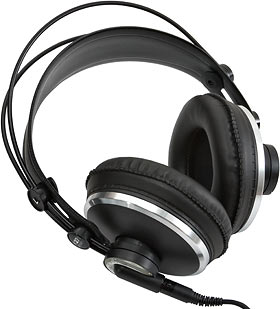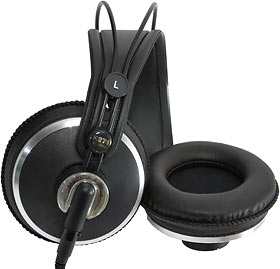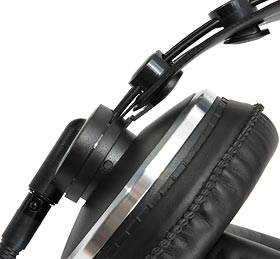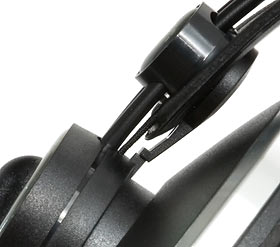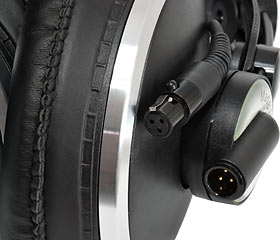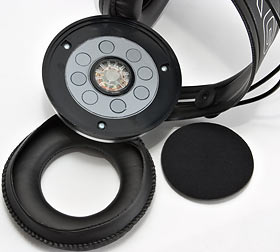
AKG K 271 Studio headphones
Review date: 8 January 2005.Last modified 03-Dec-2011.
I've been looking for a really good pair of sealed headphones for a while. As a jobbing nerd, I spend a lot of time in a room full of fairly noisy computers. Sealed headphones keep the fan racket out.
Unfortunately, I also want my headphones to sound good, and be comfortable.
These two things are a problem for sealed headphones.
First, there's the sound thing. It's much easier to make good-sounding headphones that're open-backed, with the diaphragms inside basically hanging in the open air, with nothing but protective grillework and/or foam between them and the world on each side. Sealed headphones are basically little tiny buckets over your ears, and have a tendency to sound that way, too.
And then, there's the comfort thing. Sealed headphones, by definition, need a more or less leak-less connection to your ear canal, which means the full sized around-the-ears "circumaural" versions - which're the only ones with any chance of being comfortable for long periods - have to press onto your head pretty firmly.
I've reviewed several sealed headphone options, and none have made the grade for everyday use.
Sennheiser HD 270? Sounds lousy. Sennheiser HD 212 Pro (reviewed in the same piece)? Not comfortable enough, thanks to half-size portable-friendly design (which probably also explains the massive bass boost built into the design).
Koss UR20? Don't sound very good - although they're great for the price, which is practically nothing.
Beyerdynamic DT 660? Sounds good, but not comfortable if you don't have little flat ears.
Etymotic ER-4S? Sound great, but not comfortable, possibly because they sit inside the ear.
Beyerdynamic DT 250-80? Good sound, decent comfort... could be a winner.
On, though, to the next contestant.
These are AKG's K 271 Studio headphones. Headroom in the USA sell the K271s for $US179 plus shipping - the same price as the Beyer DT 250-80s, and in the middle range of proper-hi-fi-headphone prices. And they're sealed, and they're circumaural, and they even look cool - which is unusual for sealed headphones, whose basic two-little-enclosures design makes it hard to create something funkalicious.
This look is not a one-off for AKG. They've been making headphones that look like this for ages, and have several current models that share the springy-wires-over-the-top, freeform-headband-inside appearance. Look at their range-topping wireless headphones, for instance. You don't have to spend much if all you want is this look, by the way; those cheap Koss cans are similar.
One advantage of this design is that the free-floating headband can mould to pretty much any funny shaped head; it can also be wider than most cushions attached to a solid headband.
The lack of a solid headband also keeps weight down; without the cable, these headphones weigh about 239 grams (8.4 ounces), which is pleasantly light for full-sized 'phones.
On the minus side, the spring wires up above the headband make an awful racket in your ears if you tap them. So don't do that.
This headband design is very twisty, which further improves the fit; the ear-cups can twist fore or aft to match the sides of your head, without needing fragile two-way pivots.
These ear-cups also pass the basic tests for circumaural headphone comfort - the pads are soft (though finished in smooth fake leather rather than fuzzy stuff - sealed headphones with fuzzy ear-pads don't work well), the hole in the middle is big enough for all but the beefiest of ears (the inside diameter is maybe 57mm - about 2.25 inches), and the pads are thick enough that the foam over the transducer modules doesn't press on your ears. Well, it doesn't press on my ears; they just touch it, but there isn't enough pressure to bother me. If you've got sticky-out ears, you may be less pleased.
But wait, there's more. The K 271s also have a clever automatic size adjustment system. Instead of sliding the earpieces up and down on the ends of the band to get the headphones to fit your head, you just... put them on.
There's a cunning spring loaded thread system in each earpiece which anchors to the end of the headband. When I first looked at it I thought it looked absurdly fussy, and I'm still not entirely sure that it isn't - but it works.
[Keeps working, too! I've been using these headphones almost daily for more than three years, now, and all of the important stuff is still 100% functional. The ear-pads are a bit cracked and I had to replace the cable a while ago, but that's it for failures.]
Just put the headphones on, settle the ear-pads around your ears, and you're done. They stay where they're put more than well enough for anybody who's not leaping around with their headphones on, and they don't clamp your head unduly either. They feel a bit uncertain about their location compared with headphones with a normal size-setting method, but they really do work just fine.
But wait, there's more again. In the above picture, you might have noticed another piece of plastic below and to the right of the spring-thread.
Here's a closer view.
That extra widget, present only on the left earpiece, operates a switch. When you put the headphones on, the headband slides up and the switch turns on with a tiny click. Now, the headphones work. When they're not on your head, the switch is off and the headphones don't make any noise.
What's the point of this? Well, unlike the vast majority of audio products with "Studio" in their name, the K 271s are actually made to be used in a studio. And in a studio you probably don't want headphones that aren't currently in use to be sitting there going tss-tss-tss and polluting someone else's microphone, or just interfering with the sound from the monitor speakers.
Now, in a lot of studio situations this doesn't actually matter, and you can usually match up the ear-cups of sealed headphones so they seal against themselves and make close to no noise. But the K 271s make absolutely no noise when you take 'em off, unless you accidentally hang them up by the headband or in some other way leave the little switch turned on. And, like the funny size adjustment feature, the switch seems to be bug-free and bulletproof.
It's just possible to make the switch click off if you fiddle with the headphones while you're wearing them, but just popping the left earpiece off your ear won't do it. In normal use, they really do magically make noise when you wear them, and don't when you don't.
The switch also ought to last. It's not difficult to find microswitches with mechanical life ratings of 100,000 operations or more; don and remove your headphones ten times a day, every day, and 100,000 operations gives you 13 years and eight months of switch life, even if an "operation" is an on or an off, not a full cycle. And, of course, if the switch should fail in its closed position, the headphones will still work.
The K 271s also have a plug-in cable. It's not my favourite kind of plug-in cable, though, because it locks in - you have to press a little button to remove it.
If all you want is a cable that you can replace if you drop your tungsten on it, or something, then this is fine. The funny pushbutton connector's actually a standard Mini XLR line plug, which you can buy cheaply enough if you want to roll your own cable for whatever reason. But it's still a locking connector. Non-locking plugs pop out when the cable's pulled taut, which protects the cable, the headphones and the headphone user from damage.
But the K 271 arrangement's OK. The plug isn't cumbersome, it doesn't stick, and people using the headphones in studios won't miserably watch the popped-out wire whipping away into the cable jungle behind the mixing desk.
The other end of the K 271 cable has the now-standard 1/8th inch stereo plug on it, with threads so you can firmly screw on an included 1/4 inch adapter if you like.
The cable's about three metres (10 feet) in length. If you'd like less wire flopping around the place, AKG sell an optional curly cord.)
As with all but the scungiest of headphones, the AKGs can be easily dismantled. It'd take you a long time to wear out the ear-pads, but you might find yourself taking an earpiece apart before that; sometimes a hair or two can work its way through the foam over the transducer and start buzzing.
The K 271 ear-pads just pop into place over the lip of the earpieces, which I much prefer to the common fiddly-slot type of ear-pad retention. Both arrangements make it easy to take the ear-pads off, but the slot-mount system makes it tricky to get 'em back on again.
Comfort
As mentioned above, the K 271s don't clamp your head and don't squish your ears. They're not as light and fluffy as many circumaural open-backed headphones, but they're very good indeed by sealed headphone standards. I've now worn them for many consecutive hours on several occasions, and haven't minded a bit.
The "pleather" ear cushions are inescapably going to make your ears sweat more than cloth, but if your room temperature's below 25 degrees C, you ought to be fine.
Like all light-clamping sealed headphones, the K 271s don't actually seal all that well. I found I could break the seal a bit by gritting my teeth, for instance. But since most jaw movements mean you're already screwing up your headphone audio by eating or talking, this isn't really a problem - and the compliant headband sizing system means these 'phones adapt well when you move.
Listening
The big deal about sealed headphones is how well they keep external noise out, and internal noise in; they're a good-fences-make-good-neighbours sort of product.
This sound blocking ability is called "isolation", and despite their light touch, the K 271s have quite enough isolation for me. I can still hear my office-racket through them when there's no music playing, but it doesn't take much volume to drown out the background noise. And if someone's trying to get my attention, they can do so without having to throw things at me. I still have to take the headphones off to understand what people are saying, though.
You can, of course, mask out pretty much any amount of outside noise even if you're using open headphones, by just cranking the volume way, way up. Little portable players may not be able to manage this at all, and a lot of mains-powered audio hardware can also be surprisingly lousy at it unless you add an outboard amplifier of one kind or another. But the problem with this idea is not so much that it can be hard to make the headphones sound good loud, as it is that you're going to wreck your hearing, over time. Sealed headphones save your eardrums, by letting you listen just as clearly at lower volume.
So the K 271s passed muster on the hearing-nothing front. What about when I wanted to hear something?
As I started ploughing through my usual test tracks, I was surprised to note that these headphones really don't sound sealed. They don't sound as open and airy as my usual Sennheiser HD 590s, but then part of the 590s' "air" is unnatural treble boost, which is not a bad thing to avoid; the K 271 treble is quite natural.
Midrange resonance is the big problem for many sealed headphones, and the K 271s pretty much don't have it at all.
Bass, they've got, though not amazing amounts of it; Headroom describe the 271s' bass as "slightly lean", and I concur. I'd put the emphasis on the "slightly", though; I detected no particular lack of bass when listening to critical audiophile test material.
If you're a 14-year-old who wants the most subwoofer-y experience he or she can get without actually shaking the floorboards and attracting parental attention, then these are not the headphones for you (Sennheiser HD 212 Pro, ahoy!). Everyone else ought to be quite satisfied with the 271s' low end, though.
(And, of course, you could always just use a bit of EQ.)
The K 271s also have good stereo imaging. Headphones of less than marvellous quality have trouble with this, because they don't accurately reproduce the subtle phase and frequency balance cues that your brain uses to tell where sounds are in space. But the 271s are fine; certainly no worse than the best other sealed headphones I've listened to, and possibly better.
Loudness at a given volume control setting was OK, but unremarkable. The K 271s aren't high impedance headphones; they're specified as being 55 ohms, and I measured DC impedance of only about 57 ohms per side. They're not tremendously efficient, though, so weedy portable players may still have a hard time getting decent volume out of them without an extra amplifier.
My BitHead isn't a super-powered amp, though, and it has no trouble driving the K 271s well into headache territory; I also got more than adequate volume out of a quality MP3 CD player. So no problems there.
Moving on, as usual, to random-play mode, I was pleased by the K 271s' performance with program material that actually has subtlety and layers and stereo cues and grown-up stuff like that, as well as their handling of silly things.
They buried me in coruscating weirdness quite successfully, and gave a similarly good account of themselves with all of that other stuff I listen to to show how cool I am.
My more extremely hyper-stereo old jazz was fatiguing to listen to, but it always is through headphones, even with crossfeed processing; about all you can do with a stereo recording that puts half of the band on speaker 1 and the other half on speaker 2 is press the Mono button.
On to the hard-but-not-necessarily-important numbers that HeadRoom can generate because they've got an expensive calibrated fake-head microphone system, just like the one I don't own.
HeadRoom reckon the K 271s' isolation is pretty much on par with other sealed 'phones. These headphones are pretty hopeless at blocking bass, but so is every headphone that doesn't have active noise cancellation. The K 271s are also apparently not too great at blocking noise in the mid-treble range, but I didn't hear any particular band of noise coming through. Compare the AKGs with noise cancelling 'phones and ear-plugging canalphones and the 271s don't look too good, but they sound better than the first and are much more comfortable (and cheaper) than good examples of the second, so I'll definitely give them a pass in this department.
Do a similar multi-product comparison for frequency response, and the K 271s show less than brilliant bass roll-off, a bit of undue enthusiasm between 5 and 6kHz, and the usual insanity in the high treble.
Flat frequency response just does not happen in headphones, even very highly regarded ones, though. Compared with a lot of popular speakers - especially popular consumer market speakers - headphone response weirdness is pretty minimal. Similar peaks and valleys are created by the room you put speakers in, and indeed by your ears; the name of the game for audio transducer makers is coming up with stuff that sounds sweet, not stuff that actually lives up to the "ruler-flat response" marketing balderdash.
In the distortion charts, the K 271s show a series of peaks up through the midrange, which would concern me if I could hear them. I couldn't. So there.
Overall
If these headphones were really expensive, I'd have reservations about them. They're comfortable, but could be more comfortable. They sound good (especially by sealed headphone standards), but you can get open headphones that sound just as good pretty cheaply. And they're a little under-bassed, and most headphone sockets won't be able to drive them to the ear-bleeding volume that today's discerning slackers demand.
But the K 271 Studios are not really expensive - well, not if you've already adjusted your attitude to accept that a couple of hundred bucks US is not an excessive amount to pay for quality 'phones, anyway. $US179 is an excellent price for sealed headphones of this quality.
And, as a bonus, the self-adjusting headband really works, and so does the little automatic muting switch, and these 'phones even look good. Or, at least, not bad enough that my girlfriend pointed and laughed.
Accordingly, the K 271 Studios are now my everyday office headphones; the HD 590s have been banished to a less noisy part of the house.
Highly recommended.
Review headphones kindly provided by HeadRoom.
